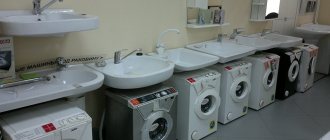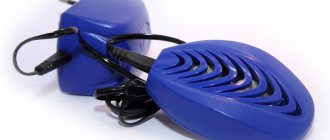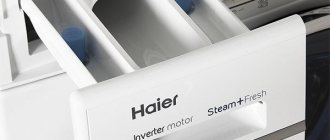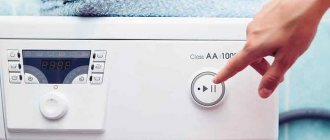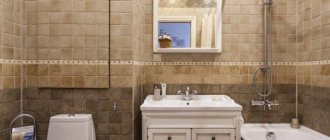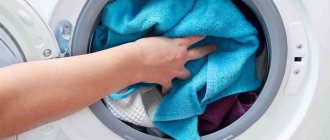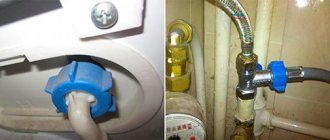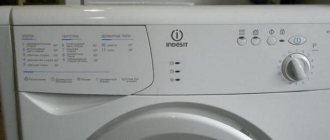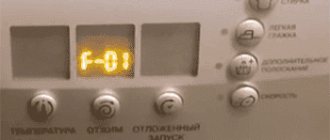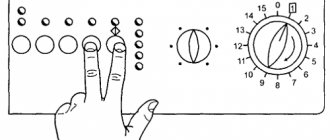It is difficult to imagine modern life without a washing machine: after all, it makes life much easier and saves time. Most often it is installed in the bathroom, but when the bathroom is too small, problems arise with the layout. How will a washing machine feel in the kitchen? Before choosing its final location, let's get acquainted with all the pros and cons of such placement.
Advantages
The most important advantage: the bathroom does not take up precious space, and it becomes freer. But besides this, there are several more advantages that you don’t immediately think about.
Safety
According to fire safety rules, electrical appliances should not be placed in rooms with high humidity, which is the bathroom. The kitchen is a different matter, here the humidity is much lower, and most often there is a window that provides active air circulation.
Work zone
Usually the washing machine is hidden behind the facade or simply covered with a countertop. In both cases, a new work surface appears, which will never be superfluous in the kitchen.
Communications
It is convenient to install the washing machine in the kitchen, since the main communications are already there: both water supply and sewerage - there is no need to install anything additional. You just have to clarify how to connect the electrical wiring, because the machine requires a dedicated line.
Wash anytime
You can do laundry in the kitchen at any time, regardless of whether anyone is taking a bath. On the other hand, noise during spinning and draining can interfere with an evening family meal or watching TV.
But, according to reviews, the same hood is louder than a washing machine. You can run the wash at night: this way the machine will not disturb anyone, and your energy bills will be lower.
What is the difference between a built-in automatic machine and a regular one?
A built-in automatic machine does not differ from a free-standing machine of the same class in programs, functions or other options that improve the quality of washing.
The only difference is the type of installation.
However, built-in models are quieter because they vibrate less. This is due to the rigid attachment to the furniture body. They are also safer to use. Manufacturers equip them with additional protection against possible leaks, foaming or strong vibration.
The advantages of built-in machines also include the following:
- Allows you to save useful space;
- Do not interfere with the aesthetic appearance of the room.
There are some disadvantages:
- Price - equipment with similar characteristics costs much more than a conventional machine;
- Small assortment - the choice of models differing in functionality is very limited;
- If repairs are necessary, the unit will have to be completely removed from the furniture.
There is no big difference between the two types of washing machines. The choice depends on the buyer’s preferences, based on the aesthetic component, price and room parameters.
Flaws
Everything has both advantages and disadvantages. And the washing machine in the kitchen is no exception. But basically, the disadvantages are not related to the machine itself, but to its “extras”.
Storing dirty laundry
Dirty laundry has an odor, and if you store it in the kitchen, it will also absorb kitchen odors. And this means that it will have to be carried to the kitchen either from the bathroom or from another room. Some people find this very inconvenient - although in fact, there is nothing critical about it.
Storing powder in the kitchen
With powder the situation is more complicated:
- it can be scattered, which is undesirable in the room where food is prepared;
- it gives off a smell that is harmful to breathe.
There are several ways out of this situation:
- store washing powder in another room;
- switch to liquid laundry detergents;
- Store the powder in a container with a good tight lid.
ADVICE. It is most convenient to store the powder in the kitchen either next to the machine or under the sink.
Open door
After washing, the machine door should be opened and the drum ventilated to prevent mold from growing in the appliance. This can interfere with passage, especially if the machine is built-in - after all, you need to open not only the machine door, but also the cabinet door.
Difficulty of change
Once the machine is already installed, it is difficult to move it somewhere else, since pipes and electrical wires are laid. But this applies not only to the kitchen, but also to other rooms.
Spoils the appearance
This does not apply to all washing machines, but only those not hidden behind the facade. Dirty laundry stored inside looks especially unsightly.
ADVICE. To make the machine look neater, you should match it to the kitchen facades, or decorate it with vinyl stickers of the same color.
If both options are not suitable, then the machine is hidden behind a beautiful matching curtain. This is especially true for kitchens in the style of Provence, Country and others.
Selecting a built-in washing machine according to criteria
Before you make a purchase, pay attention to the following points:
- Case parameters (height, depth, width). Moreover, it is better not to trust the parameters specified in the product descriptions on the Internet, but to go to the store and personally measure the dimensions of the model you are supposed to buy with a tape measure.
- Drum loading limit .
- Classes: energy efficiency (your utility bills depend on this), washing (affects the quality of washing things), spin (the higher the class, the drier the laundry at the end).
- Additional functionality and options .
- Reviews from consumers who have already purchased the device and are using it successfully (or not so much). Information in reviews on websites should be “divided by two” - the comments are not always true.
Today on the household appliances market you can find offers with the following characteristics:
- Loading from 5 to 8 kg or more.
- Spin speed: low (from 800 revolutions per minute to 1200) and high (from 1200 revolutions or more).
- With drying. With such a machine, you don’t have to buy a dryer and hang clothes around the apartment or on the balcony.
- With quick wash function. Available in the entire range, and the duration of the fast program may vary - from 14 to 30 minutes per cycle.
- With control of imbalance and foaming. In equipment without these functions, if there is increased foam formation or things get lumped together, the machine stops working and you have to drain the water or disassemble the things. If the functionality is present, then the device itself combats these problems without “straining” the user.
- With or without display. A display is a convenient solution; if it is not there, it is almost impossible to find out the washing time and get complete information about the operation of the device. Also, error codes are displayed on the display, and in conventional washing machines you have to recognize faults by flashing lights, which is very inconvenient. But devices without a screen are cheaper.
- With partial or complete protection against leaks. Partial protection applies only to the housing, but with full protection, leakage is prevented in all systems, including hoses.
- With child protection. For families with children, this function is a must. But if you make a “cunning” lock in the locker, then the option will not be needed. Although, if the car has partial installation (when the control panel remains visible), you cannot do without locking the buttons.
- The energy consumption class can be either low - B and A, or high - A+, A++ or A+++. The more pluses, the less electricity the device consumes, and you save more on bills.
- Manufacturer. The most offers for built-in units in the middle and high price segment are brands such as Miele, LG, Siemens, Samsung, AEG, Electrolux. But you can also find a relatively inexpensive model from simpler brands - Hotpoint-Ariston, Indesit, Beko, Zanussi, Whirlpool, etc. When choosing a brand, you should focus not only on its popularity, but also on the reliability and degree of trust of users. In principle, all of the listed brands are well-known among domestic consumers and inspire confidence, and most importantly, they offer good cars.
Adviсe
There are several ways to reduce the disadvantages of placing a washing machine in the kitchen:
- if it interferes with the meal with its noise, then you can postpone the washing to night time. And it’s best to adjust its legs so that the equipment is installed perfectly level - so it will be practically silent;
- The noise is also affected by the floor covering on which the machine stands. It is worth giving preference to ceramic tiles - the quietest material. But if there is laminate on the floor, then there is a high probability that the neighbors will immediately know when your machine starts spinning the laundry;
- It is best to place the washing machine next to the dishwasher and sink, thus creating a “wet” corner. This makes it more convenient to supply water, and it will be easier to clean when everything is at hand. In a corner kitchen, for ergonomic reasons, the dishwasher is placed to the right of the sink, and the washing machine is placed to the left.
There are several ways to install appliances in the kitchen. They have no significant differences in characteristics, advantages or disadvantages.
Washing machine in the kitchen with different layouts
Here are some interesting ideas on how to beautifully arrange a stationary or built-in washing machine.
- Corner kitchens with washing machine.
- Linear (straight) layout.
- U-shaped kitchen with SM.
- Double row.
Full embedding
A built-in machine in the kitchen is beautiful because it itself is not visible, everything is hidden behind the facades. The unity of style is maintained, the room seems spacious and tidy. This is one of the most common options for installing equipment, but there are several disadvantages :
- the choice of built-in machines is not at all wide;
- the cost of such equipment is significantly higher than standard analogues;
- Difficult to access if repairs are required.
This option is suitable for owners of small kitchens, for example, in Khrushchev-era apartments, when it is necessary to visually expand the space.
Manufacturers of built-in appliances clearly indicate the dimensions of cabinets for installation in their instructions. Below you will find a diagram for installing the Candy CWB 1372DN1-07 washing machine.
And here is a diagram for installing a Whirlpool AWOC 0614 washing machine:
There is a built-in cabinet. This allows you to raise the machine to the desired height, without losing precious space, since there will be storage boxes or other equipment, for example, a microwave oven, under and above it.
Advantages
Built-in appliances allow you to create a complete interior without taking up extra space in small rooms, which is its main advantage .
However, experts highlight other points, among which are:
- high safety indicators;
- the ability to independently create a workplace;
- ability to withstand prolonged intense workload;
- reduced noise level emitted by the device;
- long service life.
Partial embedding
If you don’t want to overpay for built-in appliances, you can put a regular front-loading washing machine in the kitchen and cover it with a countertop. Here it is worth considering its height, but the technique is quite standard - about 85 centimeters. The height of a standard tabletop is the same.
If a couple of centimeters are still missing, then you can remove the top cover of the washer: to do this, you need to unscrew a couple of screws on the back - this will give you a few centimeters. But then it is advisable to cover this area with either film or thin plastic.
There are two methods for partial embedding:
- without door;
- with door.
Let's consider these methods in more detail.
Without door
The essence of this arrangement is that the washing machine is simply placed next to the kitchen unit and covered with a countertop. In this case, it is important to attach the tabletop to the wall, and not just lean it on the equipment.
It turns out that the washing machine is closed only at the top, which provides a work area in the kitchen, but the machine is visible from the side. This is a plus, since it’s easier to take out and put down laundry, although aesthetically it doesn’t always look beautiful. This is where the advice of covering the equipment with a curtain, matching it, or decorating it with a vinyl sticker comes in handy.
This arrangement ensures mobility: if the machine breaks down, it’s easy to move it away and then push it back in. Therefore, this method is suitable for those for whom the main priority is convenience rather than beauty.
An example of such embedding can be seen in the photo.
With door
If you want to close the car, then a built-in one with a door is perfect. In principle, there is no actual installation here: the machine is simply placed in the kitchen unit. It is advisable to place it on the floor because the machine may shake. If this is not possible, then you should strengthen the base as much as possible: place bricks or solid wood boards under it, and also reinforce it with corners.
How to properly install and integrate an automatic washing machine under the countertop? Is this even legal?
Of course, you can’t install a standard machine like this, because it won’t fit. It is worth choosing among compact options with a depth of 45–50 cm. Their choice, unfortunately, is as small as that of built-in models, but they are more affordable.
With such an arrangement, you need to watch out for three things :
- a tray for powder - so that it does not rest against the hinges of the door of the unit, but extends out enough to add powder or pour in detergent;
- the location of the door - it is desirable that the car hatch and the door of the set open in one direction, otherwise it will be inconvenient to take out and put down laundry;
- having a margin of 2-3 centimeters on each side to prevent noise from washing.
Moreover, it is advisable to remove the back panel of the headset for air circulation and ventilation of the machine to avoid excess dampness.
Under the sink
Residents of Khrushchev-era apartment buildings sometimes take this step - installing a washing machine under the sink. This may not be the best solution, but in conditions of severe space saving, it has its place.
In this case, you need to pay special attention to the choice of washing machine under the sink:
- the height of the machine should be no more than 70 cm. Otherwise, it will be extremely difficult for small people and children to reach the sink, and they will have to substitute a stool;
- The depth of the washing machine built under the sink should be approximately 50 cm. In this case, it is necessary to take into account the gap behind the rear wall for communications and a flat siphon.
Sinks above the washing machine - Santekhniks.ru
You also need to choose the right sink. It should be a “water lily”, with a maximum height of 20 cm. For safety reasons, the drain should not touch the washing machine.
The advantages of such placement include saving space. Some even consider this layout stylish and modern. However, disadvantages here.
Firstly , these are the disadvantages associated with the small dimensions of the washing machine - neither a down jacket nor a blanket can be washed.
Secondly , the drain in a “lily pad” sink is prone to more frequent blockages.
Thirdly , for installation you will need a special siphon, which is not so easy to find.
Fourthly , there is a risk of water getting on the control board, which will lead to equipment breakdown.
Washing machine in the kitchen
Rating of the TOP 13 best built-in washing machines
| Place | Model | Price |
| With steam supply | ||
| #1 | Electrolux EW7F3R48SI | |
| #2 | Whirlpool BI WMWG 71484E | |
| #3 | Electrolux PerfectCare 700 EW7F2R48S | |
| Budget models up to 30,000 rubles | ||
| #1 | Weissgauff WMI 6128D | |
| #2 | Indesit BI WMIL 71252 | |
| #3 | Candy CBWM 914DW-07 | |
| Middle segment | ||
| #1 | Hotpoint-Ariston BI WMHL 71283 | |
| #2 | MAUNFELD MBWM.148W | |
| #3 | Midea WMB8141 | |
| #4 | Korting KWMI 1480 W | |
| Premium segment from 60,000 rubles | ||
| #1 | Bosch WIW 28540 | |
| #2 | NEFF W6440X0 | |
| #3 | Smeg LST147-2 | |
Page navigation:
Connecting the machine to communications
When connecting the washing machine to communications, several points should be taken into account:
- to connect the machine directly to the sewer, you will need to purchase an additional siphon;
- the pipe must be installed without kinks and straightened along its entire length;
- It is necessary to install an additional valve on the cold water pipe and turn it off after each wash;
- To supply water to the machine, special tees or pipes are used.
To ensure that the machine vibrates minimally during operation, its position should be leveled using a water level , using adjustable legs or thick rubber inserts.
